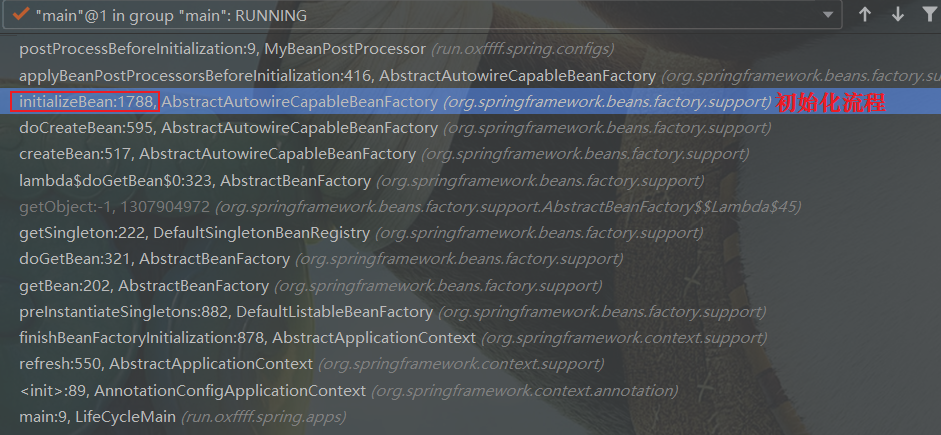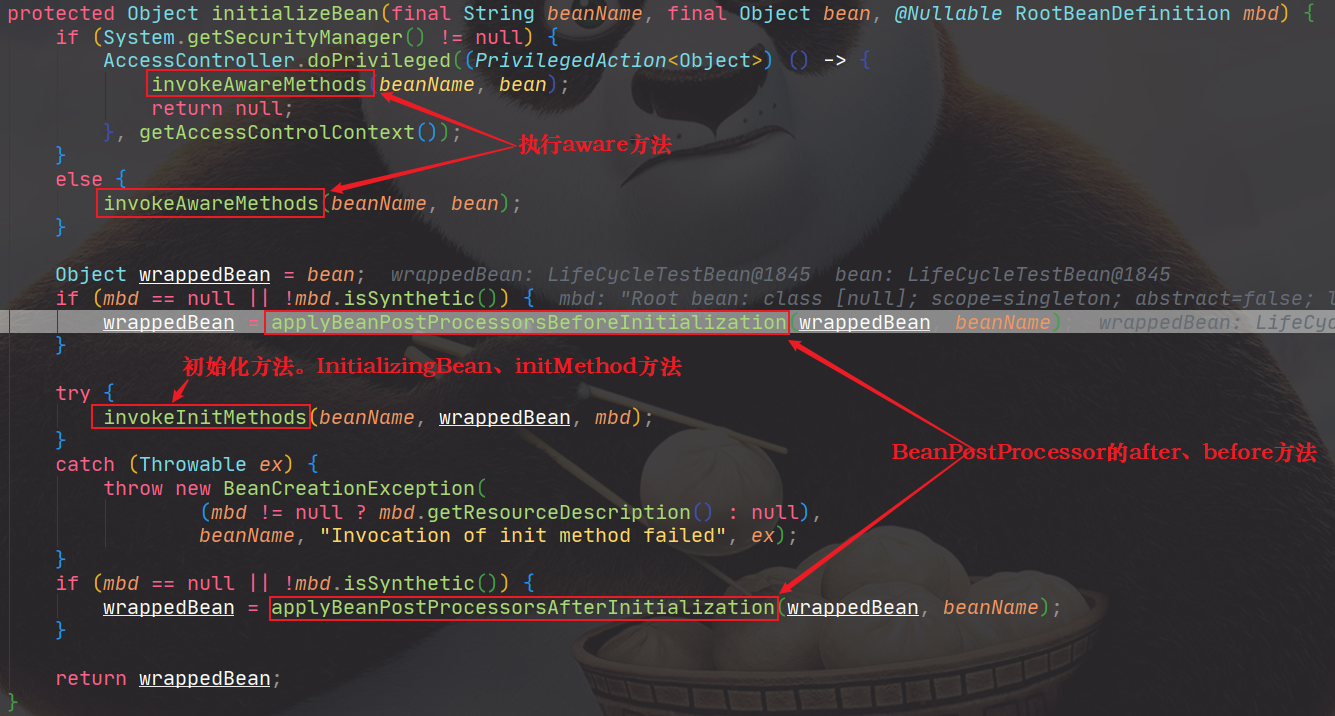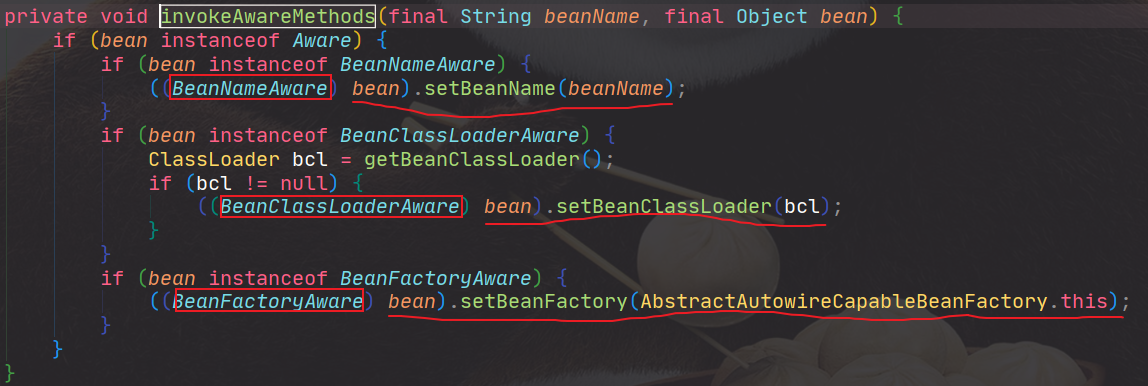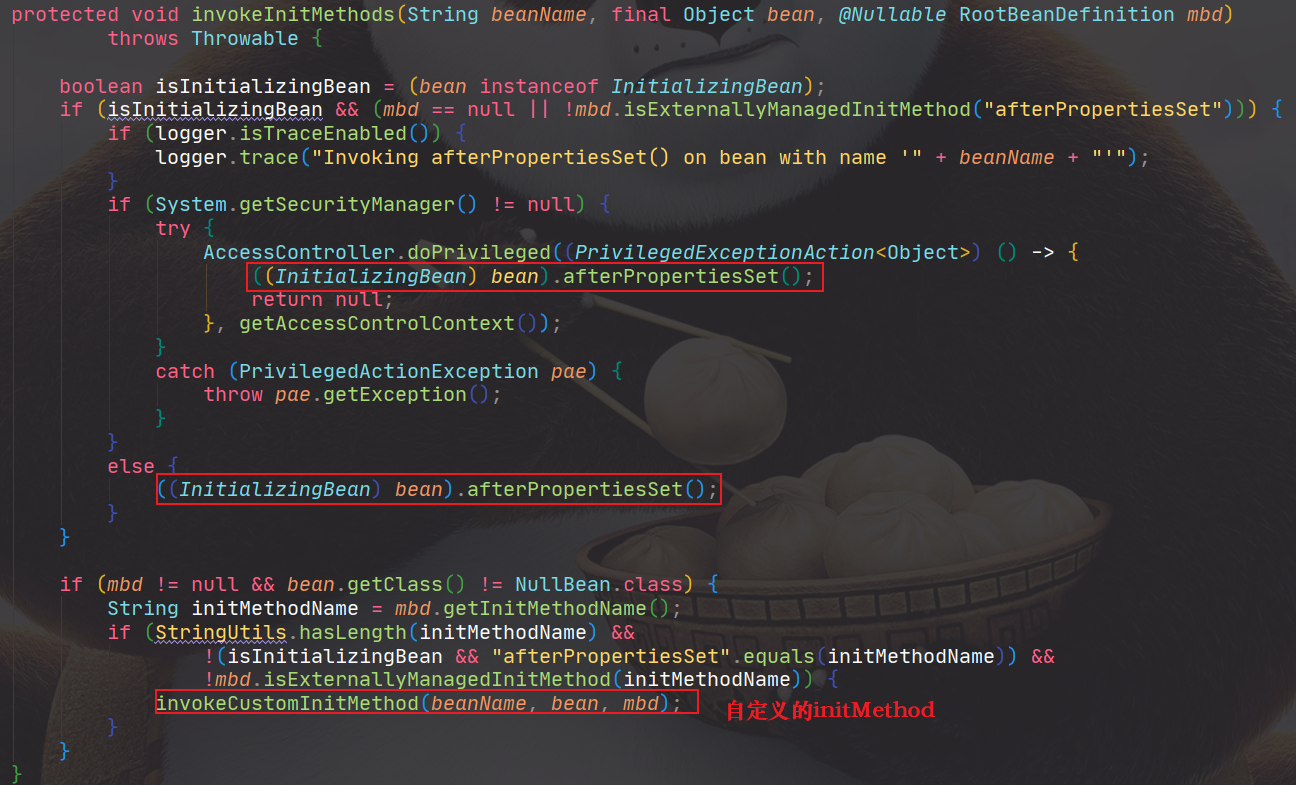这一篇主要学到了一种新的看源代码的方法。之前都是从最开始的代码开始,然后一步一步step into。这样会比较浪费时间,并且会因为代码多而容易搞混淆,抓不住重点。
这篇主要是看BeanPostProcessor的执行时机与相应的源代码,目前对于它是合适执行的,并不知道,但是可以明确的是我们继承的BeanPostProcessor一定会执行。因此可以完全将断点放在我们写的类MyBeanPostProcessor的函数里面。
看源码的另一种姿势
打开调试,进入断点。如下图所示:

然后逐帧查看其调用栈,慢慢找到关键代码:

初始化流程
主要的初始化流程包括:XXXAware方法执行、BeanPostProcessor.beforeXX()、InitilizingBean、initMethod、BeanPostProcessor.afterXX()。

执行AwareXX的顺序如下:

执行applyBeanPostProcessorsBeforeInitialization时,如果BeanPostProcessor返回的是null,那么将不会执行后续的BeanPostProcessor。

然后先执行InitializingBean,再调用自定义初始化方法initMethod。

最后执行BeanPostProcessor.afterXX(),与before的类似。
在Spring中的用途
先看两个比较简单的,会直接调用BeanPostProcessor的两个方法,达到spring的相应功能。
ApplicationContextAwareProcessor
在bean中,实现ApplicationContextAware接口,这个后置处理器会在bean初始化前,设置进ApplicationContext。
1
2
3
4
5
6
7
8
9
10
11
12
13
14
15
16
17
18
19
20
21
22
23
24
25
26
27
28
29
30
31
32
33
34
35
36
37
38
39
40
41
42
43
44
45
46
47
48
| @Override
@Nullable
public Object postProcessBeforeInitialization(Object bean, String beanName) throws BeansException {
if (!(bean instanceof EnvironmentAware || bean instanceof EmbeddedValueResolverAware ||
bean instanceof ResourceLoaderAware || bean instanceof ApplicationEventPublisherAware ||
bean instanceof MessageSourceAware || bean instanceof ApplicationContextAware)){
return bean;
}
AccessControlContext acc = null;
if (System.getSecurityManager() != null) {
acc = this.applicationContext.getBeanFactory().getAccessControlContext();
}
if (acc != null) {
AccessController.doPrivileged((PrivilegedAction<Object>) () -> {
invokeAwareInterfaces(bean);
return null;
}, acc);
}
else {
invokeAwareInterfaces(bean);
}
return bean;
}
private void invokeAwareInterfaces(Object bean) {
if (bean instanceof EnvironmentAware) {
((EnvironmentAware) bean).setEnvironment(this.applicationContext.getEnvironment());
}
if (bean instanceof EmbeddedValueResolverAware) {
((EmbeddedValueResolverAware) bean).setEmbeddedValueResolver(this.embeddedValueResolver);
}
if (bean instanceof ResourceLoaderAware) {
((ResourceLoaderAware) bean).setResourceLoader(this.applicationContext);
}
if (bean instanceof ApplicationEventPublisherAware) {
((ApplicationEventPublisherAware) bean).setApplicationEventPublisher(this.applicationContext);
}
if (bean instanceof MessageSourceAware) {
((MessageSourceAware) bean).setMessageSource(this.applicationContext);
}
if (bean instanceof ApplicationContextAware) {
((ApplicationContextAware) bean).setApplicationContext(this.applicationContext);
}
}
|
BeanValidationPostProcessor
此方法默认在初始化数据之前进行数据校验。
1
2
3
4
5
6
7
8
9
10
11
12
13
14
15
16
17
18
19
20
21
22
23
24
25
26
27
28
29
30
31
32
33
34
35
36
37
38
| private boolean afterInitialization = false;
@Override
public Object postProcessBeforeInitialization(Object bean, String beanName) throws BeansException {
if (!this.afterInitialization) {
doValidate(bean);
}
return bean;
}
@Override
public Object postProcessAfterInitialization(Object bean, String beanName) throws BeansException {
if (this.afterInitialization) {
doValidate(bean);
}
return bean;
}
protected void doValidate(Object bean) {
Assert.state(this.validator != null, "No Validator set");
Object objectToValidate = AopProxyUtils.getSingletonTarget(bean);
if (objectToValidate == null) {
objectToValidate = bean;
}
Set<ConstraintViolation<Object>> result = this.validator.validate(objectToValidate);
if (!result.isEmpty()) {
StringBuilder sb = new StringBuilder("Bean state is invalid: ");
for (Iterator<ConstraintViolation<Object>> it = result.iterator(); it.hasNext();) {
ConstraintViolation<Object> violation = it.next();
sb.append(violation.getPropertyPath()).append(" - ").append(violation.getMessage());
if (it.hasNext()) {
sb.append("; ");
}
}
throw new BeanInitializationException(sb.toString());
}
}
|
InitDestroyAnnotationBeanPostProcessor
执行被@PostConstruct和@PreDestroy注解的方法,参与生命周期。
初始化方法执行
@PostConstruct执行过程比较直接,因为此类直接实现了BeanPostProcessor的初始化方法。
1
2
3
4
5
6
7
8
9
10
11
12
13
14
15
16
17
18
19
20
| @Override
public Object postProcessBeforeInitialization(Object bean, String beanName) throws BeansException {
LifecycleMetadata metadata = findLifecycleMetadata(bean.getClass());
try {
metadata.invokeInitMethods(bean, beanName);
}
catch (InvocationTargetException ex) {
throw new BeanCreationException(beanName, "Invocation of init method failed", ex.getTargetException());
}
catch (Throwable ex) {
throw new BeanCreationException(beanName, "Failed to invoke init method", ex);
}
return bean;
}
@Override
public Object postProcessAfterInitialization(Object bean, String beanName) throws BeansException {
return bean;
}
|
具体的初始化方法如下:
1
2
3
4
5
6
7
8
9
10
11
12
13
| public void invokeInitMethods(Object target, String beanName) throws Throwable {
Collection<LifecycleElement> checkedInitMethods = this.checkedInitMethods;
Collection<LifecycleElement> initMethodsToIterate =
(checkedInitMethods != null ? checkedInitMethods : this.initMethods);
if (!initMethodsToIterate.isEmpty()) {
for (LifecycleElement element : initMethodsToIterate) {
if (logger.isTraceEnabled()) {
logger.trace("Invoking init method on bean '" + beanName + "': " + element.getMethod());
}
element.invoke(target);
}
}
}
|
寻找bean中初始化、销毁方法
所有的checkedInitMethods来自对initMethods中函数的遍历。包括destroy方法也是类似的。
1
2
3
4
5
6
7
8
9
10
11
12
13
14
15
16
17
18
19
20
21
22
23
24
25
26
| public void checkConfigMembers(RootBeanDefinition beanDefinition) {
Set<LifecycleElement> checkedInitMethods = new LinkedHashSet<>(this.initMethods.size());
for (LifecycleElement element : this.initMethods) {
String methodIdentifier = element.getIdentifier();
if (!beanDefinition.isExternallyManagedInitMethod(methodIdentifier)) {
beanDefinition.registerExternallyManagedInitMethod(methodIdentifier);
checkedInitMethods.add(element);
if (logger.isTraceEnabled()) {
logger.trace("Registered init method on class [" + this.targetClass.getName() + "]: " + element);
}
}
}
Set<LifecycleElement> checkedDestroyMethods = new LinkedHashSet<>(this.destroyMethods.size());
for (LifecycleElement element : this.destroyMethods) {
String methodIdentifier = element.getIdentifier();
if (!beanDefinition.isExternallyManagedDestroyMethod(methodIdentifier)) {
beanDefinition.registerExternallyManagedDestroyMethod(methodIdentifier);
checkedDestroyMethods.add(element);
if (logger.isTraceEnabled()) {
logger.trace("Registered destroy method on class [" + this.targetClass.getName() + "]: " + element);
}
}
}
this.checkedInitMethods = checkedInitMethods;
this.checkedDestroyMethods = checkedDestroyMethods;
}
|
只要是被@PostConstruct注解过的函数,都会被加入到initMethods中。destroy也类似。
1
2
3
4
5
6
7
8
9
10
11
12
13
14
15
16
17
18
19
20
21
22
23
24
25
26
27
28
29
30
| do {
final List<LifecycleElement> currInitMethods = new ArrayList<>();
final List<LifecycleElement> currDestroyMethods = new ArrayList<>();
ReflectionUtils.doWithLocalMethods(targetClass, method -> {
if (this.initAnnotationType != null && method.isAnnotationPresent(this.initAnnotationType)) {
LifecycleElement element = new LifecycleElement(method);
currInitMethods.add(element);
if (logger.isTraceEnabled()) {
logger.trace("Found init method on class [" + clazz.getName() + "]: " + method);
}
}
if (this.destroyAnnotationType != null && method.isAnnotationPresent(this.destroyAnnotationType)) {
currDestroyMethods.add(new LifecycleElement(method));
if (logger.isTraceEnabled()) {
logger.trace("Found destroy method on class [" + clazz.getName() + "]: " + method);
}
}
});
initMethods.addAll(0, currInitMethods);
destroyMethods.addAll(currDestroyMethods);
targetClass = targetClass.getSuperclass();
}
while (targetClass != null && targetClass != Object.class);
return (initMethods.isEmpty() && destroyMethods.isEmpty() ? this.emptyLifecycleMetadata :
new LifecycleMetadata(clazz, initMethods, destroyMethods));
|
具体的类型为:
init

destroy

销毁方法执行
对@PreDestroy注解方法的执行,逻辑都放在了DisposableBeanAdapter中,它实现了DisposableBean,

并实现了destroy()方法,执行所有的DestructionAwareBeanPostProcessor方法。

进入InitDestroyAnnotationBeanPostProcessor的postProcessBeforeDestruction,它完成了对所有的销毁方法的调用。

具体的执行销毁方法的逻辑与初始化类似

















